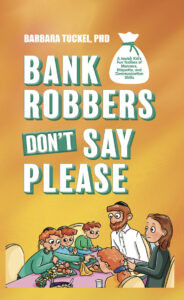In Barbara Tuckel’s guidebook for young readers, BANK ROBBERS DON’T SAY PLEASE (Menucha Publishers, 2023), a boy named Michoel often gets in sticky situations which require him to learn about manners and etiquette. Readers will be engaged and entertained while learning helpful life skills with overarching Jewish themes. The book has activities, lots of colorful graphics, and engaging illustrations. There’s something for everyone to learn in BANK ROBBERS DON’T SAY PLEASE.
I’m so happy to learn more about Barbara and her writing process. Welcome, Barbara!
What inspired you to write an etiquette book for young readers?
Thank you, Barbara, for inviting me to participate in your blog. Jewish education emphasizes the development of good middos, or positive character traits that show regard for others. I wrote BANK ROBBERS DON’T SAY PLEASE because good manners and age-appropriate speaking skills are integral to this process. Learning to use a knife and fork instead of your hands; listening wholeheartedly when others speak instead of interrupting are two examples that the book teaches as not being superfluous social niceties passed down from the upper class. Instead, my goal in BANK ROBBERS DON’T SAY PLEASE is to show young readers that when they practice basic good manners they are acquiring more middos that show kindness and respect to others because they are making it much more pleasant for others to be around them.

How did you come up with the fun title, BANK ROBBERS DON’T SAY PLEASE?
Children often have a hard time acquiring the habit of saying “please” when they want something. I thought a lot about this while I wrote the book and realized the powerfulness of this word is undervalued. When we omit “please” from a request we are actually commanding someone. “Give me water” does not acknowledge the possibility of being refused; “please give me water” recognizes that the request can be refused. I thought of instances where people deliberately don’t say “please” because they are commanding and don’t want to give the other person the freedom to say “no.” That led me to the title, BANK ROBBERS DON’T SAY PLEASE.
The format of BANK ROBBERS DON’T SAY PLEASE is engaging and interactive. How did you plan for the structure, including the storytelling element, hints, fun facts, and “manner in a minute” tips?
Thank you for asking this question; it brought me back to the challenging process I went through. I built the book layer by layer, never really expecting the end result. From the outset I thought it was important to add in “Fun Facts” about the origins and reasons for some of the basic manners and etiquette followed today. My grandchildren inspired me to create a fictional hero, Michoel, and his family. I felt that putting Michoel in wacky situations where he failed to use good manners or appropriate communication skills would add humor to what is usually viewed as a staid subject. From the fictional Cohen family and Michoel’s etiquette emergencies, other parts of the structure grew naturally. For example, Michoel finds himself in situations where he has to think quickly, such as when he is a guest a someone else’s table and doesn’t like the food. This led me to create “Manner in a Minute” where I tell the reader what to do when the immediate situation is ambiguous and potentially embarrassing. The “Tool Box” section at the end of each chapter is quick summary so that the reader can see that these behaviors are not difficult to acquire and can be learned a few at a time, with practice.
Do you picture kids reading the book on their own or working through it with a parent?
I think kids initially need to be introduced to the book by a parent or another adult. Incidentally, the initial response to my book from adults has been strongly enthusiastic followed by the hope for sequel for adults! By contrast, the 10-12 year olds I often turn to for opinions wonder why they would ever need such a book. This is understandable because the topics, manners and etiquette, are not immediately of interest to young readers until they meet the book’s hero, Michoel and start following the funny situations in which he finds himself. As each chapter does a “re-take” of Michoel’s humorous mistakes and teaches what should have happened, it would be useful to have an adult reading the book too. At this point children can discuss applications to their own family situation and peer group.

What do you hope young readers come away with after completing BANK ROBBERS DON’T SAY PLEASE?
The last chapter in my book is a meeting between the fictional Michoel and me to debrief about his mistakes and ultimate successes. I hope that young readers understand, as Michoel does, that using these tools is not difficult at all. Also, I would like the children who read my book to take away what Michoel says he learned from the situations I put him in: that practicing good manners, etiquette, and appropriate spoken communication are helping him build good middos, and that these behaviors are inseparable from having the kind of refined Jewish personality that Michoel wants to develop.
Thank you, Barbara!
Barbara Tuckel has a PhD in Speech Communication and spent her career working at InVision, Inc., a qualitativie research company in Stamford, Ct. At InVision, she was a focus group moderator and communications coach. Barbara interviewed children and adults for Fortune 100 companies including Scholastic Book Clubs for Children. In that capacity she interviewed hundreds of parents and children. Barbara continues to work as a speech coach for adults and children who want to improve their communication skills. Both age groups often come to her to learn how to hold conversations, overcome shyness, be more concise, or listen better. Barbara has two daughters and nine grandchildren. She lives with her husband in Queens, New York.